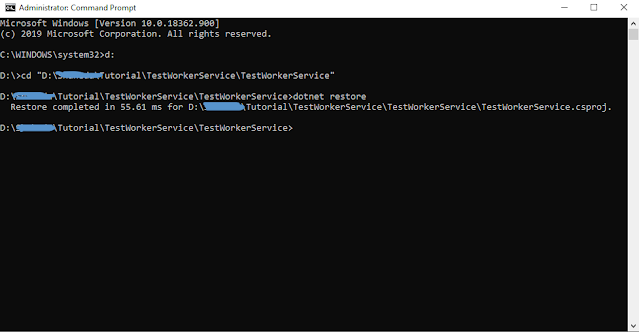Asp.net core 3 brings a very interesting new feature “Worker Service”. It is an Asp.net core template that allows you to create hosted long-running background services. These background services implements the IHostedService interface, so they are called hosted services.
Worker services are the perfect use case for
any background processing such as components in an ETL pipeline, processing messages from a Kafka,
Rabbit
or SQS
queue. Perhaps you want to run customised health checks on your systems. Any
processing job you can think of where you need a simple, straightforward
framework to do so, Worker Services now has you covered.
Worker Service template
The ASP.NET Core Worker Service template provides a starting point for writing long running service apps. An app created from the Worker Service template specifies the Worker SDK in its project file.
An app based on
the Worker Service template uses the Microsoft.NET.Sdk.Worker SDK and has an explicit
package reference to the Microsoft.Extensions.Hosting package
Worker service
implements the BackgroundService
BackgroundService base class
BackgroundService is a base class for implementing a long running IHostedService.
ExecuteAsync(CancellationToken) is called to run the
background service. The implementation returns a Task that represents the entire
lifetime of the background service. No further services are started until ExecuteAsync becomes asynchronous, such as by calling await. Avoid performing long,
blocking initialization work in ExecuteAsync. The host blocks in StopAsync(CancellationToken) waiting for ExecuteAsync to complete.
The cancellation
token is triggered when IHostedService.StopAsync is called. Your
implementation of ExecuteAsync should finish promptly when the
cancellation token is fired in order to gracefully shut down the service.
Otherwise, the service ungracefully shuts down at the shutdown timeout.
Getting
Started
1. Open visual studio and create new project. Give the project name and create the worker service.
2. After creating worker service in solution explorer you will get the following files.
3. Open
the Program.cs file you will get the following function
In this we have two methods, Main which is the entry point of our application and CreateHostBuilder which will bootstrap our application, Configure our services and setup any dependencies that we need.
The CreateHostBuilder is where you can add
your configuration management, IoC or any additional startup configuration you
may need.
The Worker
The template has already provided an example of a basic worker service, with IoC and its own managed lifecycle.
The template utilises IoC to inject a logger into our service and manages its lifecycle via a CancellationToken that’s passed in by the .NET Core framework. Most worker services wouldn’t differ too much from this implementation unless of course, you were using an external source (i.e. feature flag) to handle the lifecycle.
You can also override the function StartAsync and StopAsync function.
StartAsync(CancellationToken):
StartAsync
contains the logic to start the background task.StartAsync
is called before:
- The
app's request processing pipeline is configured (
Startup.Configure). - The server is started and IApplicationLifetime.ApplicationStarted is triggered.
The default behavior can be
changed so that the hosted service's StartAsync
runs after the app's pipeline has been configured and ApplicationStarted is called.
StopAsync(CancellationToken):
Triggered when the host is performing a graceful shutdown.StopAsnc
contains the logic to end the background task. Implement IDisposable
and finalizers
(destructors)
to dispose of any unmanaged resources.
The cancellation token has a default five second timeout to indicate that the shutdown process should no longer be graceful. When cancellation is requested on the token:
- Any remaining background operations that the app is performing should be aborted.
- Any methods called in
StopAsyncshould return promptly
However, tasks aren't abandoned after cancellation is requested—the caller awaits all tasks to complete.
If the app shuts down
unexpectedly (for example, the app's process fails), StopAsnc
might not be called. Therefore, any methods called or operations conducted in StopAsnc
might not occur.
To extend the default five second shutdown timeout, set:
- ShutdownTimeout when using Generic Host.
- Shutdown timeout host configuration setting when using Web Host.
The hosted service is
activated once at app startup and gracefully shut down at app shutdown. If an
error is thrown during background task execution, Dispose should be called even if StopAsnc
isn't called.
Running the worker
These workers can be run in the same fashion that you’d run a Console Application (or most .NET Core applications)
If you run the application it will continuously displayed the output until cancellation is provided
Running as a windows service
If you’re looking to run as a Windows service, you’ll need to configure the template slightly.
Start by downloading the Microsoft.Extensions.Hosting.WindowsServices NuGet package and adding it to your project
Now inside your program.cs add UseWindowsService() to your CreateHostBuilder
To host the service as a windows service run the following command.
Open the command prompt as administrator.
Go to your application path
And run the command dotnet restore
After that publish the service using the command
dotnet publish -o ./publish/service
After that host the worker service as a windows service using the following command
sc.exe create MyWorkerService binpath= ./publish/service/TestWorkerService.exe
if all goes well, You should see your Windows Service created and runnable from the service manager!




















No comments:
Post a Comment